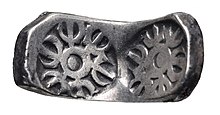Punch-marked coins
This article needs additional citations for verification. (July 2017) |

Punch-marked coins are a type of early coinage of India, dating to between about the 6th and 2nd centuries BC. It was of irregular shape.
History


Punch-marked coins are a type of early coinage of India, dating to between about the 6th and 2nd centuries BCE. The study of the relative chronology of these coins has successfully established that the first punch-marked coins initially only had one or two punches, with the number of punches increasing over time.[1]
The first coins in India may have been minted around the 6th century BCE[citation needed] by the Mahajanapadas of the Indo-Gangetic Plain. They were certainly produced by the mid-4th century BCE, shortly before the invasion of Alexander the Great in the 4th century BCE. According to Joe Cribb, Indian punch-marked coins go back to the mid-4th century BCE or slightly earlier, and actually started with the punch-marked coinage of the Achaemenids in the Kabul/ Gandhara area.[1] 19th-century proposals which suggested an origin from as early as 1000 BC, independent of the introduction of coins in Asia Minor, are "no longer given any credence".[1]
The coins of this period were punch-marked coins called Puranas, Karshapanas or Pana. Several of these coins had a single symbol, for example, Saurashtra had a humped bull, and Dakshin Panchala had a Swastika, others, like Magadha, had several symbols. These coins were made of silver of a standard weight but with an irregular shape. This was gained by cutting up silver bars and then making the correct weight by cutting the edges of the coin.[2]
They are mentioned in the Manu, Panini, and Buddhist Jataka stories and lasted three centuries longer in the south than the north (600 BCE – 300 CE).[3]
Greek and Achaemenid coinage in northwestern India (6th century onward)


Coin finds in the Kabul hoard or the Shaikhan Dehri hoard in Pushkalavati have revealed numerous Achaemenid coins as well as many Greek coins from the 5th and 4th centuries BCE were circulating in the area, at least as far as the Indus during the reign of the Achaemenids, who were in control of the areas as far as Gandhara.[9][10][7][11] In 2007 a small coin hoard was discovered at the site of ancient Pushkalavati (Shaikhan Dehri) in Pakistan. The hoard contained a tetradrachm minted in Athens c. 500/490-485/0 BCE, together with a number of local types as well as silver cast ingots. The Athens coin is the earliest known example of its type to be found so far to the east.[12]
According to Joe Cribb, these early Greek coins were at the origin of Indian punch-marked coins, the earliest coins developed in India, which used minting technology derived from Greek coinage.[7] Daniel Schlumberger also considers that punch-marked bars, similar to the many punch-marked bars found in northwestern India, initially originated in the Achaemenid Empire, rather than in the Indian heartland:
“The punch-marked bars were up to now considered to be Indian (...) However the weight standard is considered by some expert to be Persian, and now that we see them also being uncovered in the soil of Afghanistan, we must take into account the possibility that their country of origin should not be sought beyond the Indus, but rather in the oriental provinces of the Achaemenid Empire"
— Daniel Schlumberger, quoted from Trésors Monétaires, p.42.[11]
Mauryan Period (322–185 BCE)

After the Mauryan period, punch-marked coins continued to be issued in large quantities. Similarly, the coinage of the Mauryan Empire was an example of the punch-marked coinage of Magadha. Each coin contained on average 50–54 grains of silver depending on wear and 32 rattis in weight,[13] and earlier coins are flatter than later coins. Punches on these coins count to 450 different types with the most common the sun and six-armed symbols, and various forms of geometrical patterns, circles, wheels, human figures, various animals, bows and arrows, hills and trees etc.
Punch-marked coins are mentioned in the Manu, Panini, and Buddhist Jataka stories. They continued circulating in the North until approximately the beginning of the first century CE, but lasted three centuries longer in the South, i.e. until about 300 CE.[14]
In the North, following the fall of the Maurya Empire and the increased influence of the Greco-Bactrians and Indo-Greeks, punch-marked coins were replaced by cast die-struck coins, as visible in the Post-Mauryan coinage of Gandhara.
See also
References
- ^ a b c Cribb, Joe. Investigating the introduction of coinage in India- a review of recent research, Journal of the Numismatic Society of India xlv (Varanasi 1983), pp.95-101. pp. 85–86.
- ^ Śrīrāma Goyala (1994). The Coinage of Ancient India. Kusumanjali Prakashan.
- ^ "Puranas or Punch-Marked Coins (circa 600 BC – circa 300 AD)". Government Museum Chennai. Retrieved 2007-09-06.
- ^ http://coinindia.com/galleries-surashtra.html Accessed 06/03/2007
- ^ Allan & Stern (2008)
- ^ CNG Coins
- ^ a b c Errington, Elizabeth; Trust, Ancient India and Iran; Museum, Fitzwilliam (1992). The Crossroads of Asia: transformation in image and symbol in the art of ancient Afghanistan and Pakistan. Ancient India and Iran Trust. pp. 57–59. ISBN 9780951839911.
- ^ CNG Coins
- ^ Bopearachchi, Osmund. “Coin Production and Circulation in Central Asia and North-West India (Before and after Alexander’s Conquest)”. pp. 300–301.
- ^ US Department of Defense
- ^ a b Bopearachchi, Osmund. “Coin Production and Circulation in Central Asia and North-West India (Before and after Alexander’s Conquest)”. pp. 308-.
- ^ CNG Coins
- ^ "Archived copy". Archived from the original on 2005-06-18. Retrieved 2005-06-18.
{{cite web}}: CS1 maint: archived copy as title (link) accessed 15/2/2007 - ^ "Puranas or Punch-Marked Coins (circa 600 BCE – circa 300 CE)". Government Museum Chhennai. Retrieved 2007-09-06.
